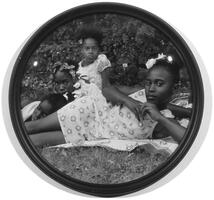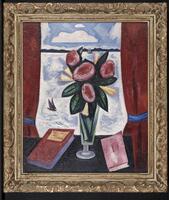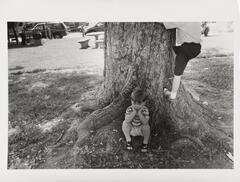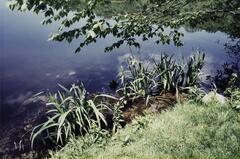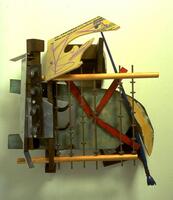You’ve got to admit it—Ann Arbor is especially great during the summer. Even without our favorite live events (Summer Festival, Ann Arbor Art Fair), there’s a lot of fun to be had on the Huron River, in shady parks, and at ice cream shops. You may glimpse these typical summer scenes from your window, in your neighborhood, or as you wander through town. Each code represents one activity or moment that makes summer memorable. What’s your favorite part of summer in Ann Arbor?
7 Items in this Learning Collection
Resource with 1 media
Resource with 1 media
Resource with 1 media
Resource with 1 media
Resource with 1 media
Resource with 1 media
Collection Object
Copyright
Creative Commons by-nc-sa
()
Playskool Gym, from the Playskool series
Accession Number
1989/2.1
Title
Playskool Gym, from the Playskool series
Artist(s)
Frank Stella
Artist Nationality
American (North American)
Object Creation Date
1983
Medium & Support
patinated cast bronze, fabricated aluminum, wood, steel, plastic, screenprint
Dimensions
28 3/8 in. x 23 13/16 in. x 11 7/16 in. ( 72 cm x 60.5 cm x 29 cm )
Credit Line
Museum Purchase made possible by the Friends of the Museum of Art
Label copy
Beginning in the early 1980s, Frank Stella developed the nine-piece "Playskool" series of wall reliefs. "Playskool Gym" is a visual Tinker-Toy that includes wood, irregularly-shaped metal objects, and found objects— including steel rods, ratcheted discs, and a paintbrush. These elements invade the surrounding space and invite the viewer to move around the piece in order to engage with it. "Playskool" refers to the extremely popular early-learning toys produced for young children by the Fisher-Price Company. Stella created his own line of "late-learning" educational toys for mental gymnastics, a "jungle gym" of poles and bars designed for curious and inventive viewers to climb, swing, jump and otherwise exercise their minds. Not coincidentally, early versions of the "Playskool Gym" were done during the year that his son was born.
Massachusetts-born Frank Stella is primarily known as a painter of huge canvases. He is also known for being a pioneer of Post-Painterly Abstraction, a staunch reaction to the Abstract Expressionists’ domination of the New York galleries in the 1950s. Post-Painterly Abstractionists believed that the physical materials and qualities of a work of art were what should be celebrated, rather than emotional associations or intellectual references.
(A. Dixon, 20th Century Gallery installation, June 1999)
Subject matter
One from a nine-piece series of wall reliefs by Stella created in the early 1980s. Playskool refers to the popular early-learning toys produced for children by the Fisher-Price Company. Stella created his own visual Tinker-Toy, which encourages viewers to perform mental gymnastics, a kind of “jungle gym” for viewers to exercise their minds.
Physical Description
Wall sculpture created from wood, irregularly shaped metal objects, and found objects—including steel rods, ratcheted discs and a paintbrush.
Primary Object Classification
Sculpture
Primary Object Type
assemblage
Additional Object Classification(s)
Mixed Media
Collection Area
Modern and Contemporary
Rights
If you are interested in using an image for a publication, please visit http://umma.umich.edu/request-image for more information and to fill out the online Image Rights and Reproductions Request Form.
Keywords
American (North American)
Neo-Dada
abstraction
found objects
junk sculpture
modern and contemporary art
play (recreation)
toys (recreational artifacts)
1989/2.1
Title
Playskool Gym, from the Playskool series
Artist(s)
Frank Stella
Artist Nationality
American (North American)
Object Creation Date
1983
Medium & Support
patinated cast bronze, fabricated aluminum, wood, steel, plastic, screenprint
Dimensions
28 3/8 in. x 23 13/16 in. x 11 7/16 in. ( 72 cm x 60.5 cm x 29 cm )
Credit Line
Museum Purchase made possible by the Friends of the Museum of Art
Label copy
Beginning in the early 1980s, Frank Stella developed the nine-piece "Playskool" series of wall reliefs. "Playskool Gym" is a visual Tinker-Toy that includes wood, irregularly-shaped metal objects, and found objects— including steel rods, ratcheted discs, and a paintbrush. These elements invade the surrounding space and invite the viewer to move around the piece in order to engage with it. "Playskool" refers to the extremely popular early-learning toys produced for young children by the Fisher-Price Company. Stella created his own line of "late-learning" educational toys for mental gymnastics, a "jungle gym" of poles and bars designed for curious and inventive viewers to climb, swing, jump and otherwise exercise their minds. Not coincidentally, early versions of the "Playskool Gym" were done during the year that his son was born.
Massachusetts-born Frank Stella is primarily known as a painter of huge canvases. He is also known for being a pioneer of Post-Painterly Abstraction, a staunch reaction to the Abstract Expressionists’ domination of the New York galleries in the 1950s. Post-Painterly Abstractionists believed that the physical materials and qualities of a work of art were what should be celebrated, rather than emotional associations or intellectual references.
(A. Dixon, 20th Century Gallery installation, June 1999)
Subject matter
One from a nine-piece series of wall reliefs by Stella created in the early 1980s. Playskool refers to the popular early-learning toys produced for children by the Fisher-Price Company. Stella created his own visual Tinker-Toy, which encourages viewers to perform mental gymnastics, a kind of “jungle gym” for viewers to exercise their minds.
Physical Description
Wall sculpture created from wood, irregularly shaped metal objects, and found objects—including steel rods, ratcheted discs and a paintbrush.
Primary Object Classification
Sculpture
Primary Object Type
assemblage
Additional Object Classification(s)
Mixed Media
Collection Area
Modern and Contemporary
Rights
If you are interested in using an image for a publication, please visit http://umma.umich.edu/request-image for more information and to fill out the online Image Rights and Reproductions Request Form.
Keywords
American (North American)
Neo-Dada
abstraction
found objects
junk sculpture
modern and contemporary art
play (recreation)
toys (recreational artifacts)
